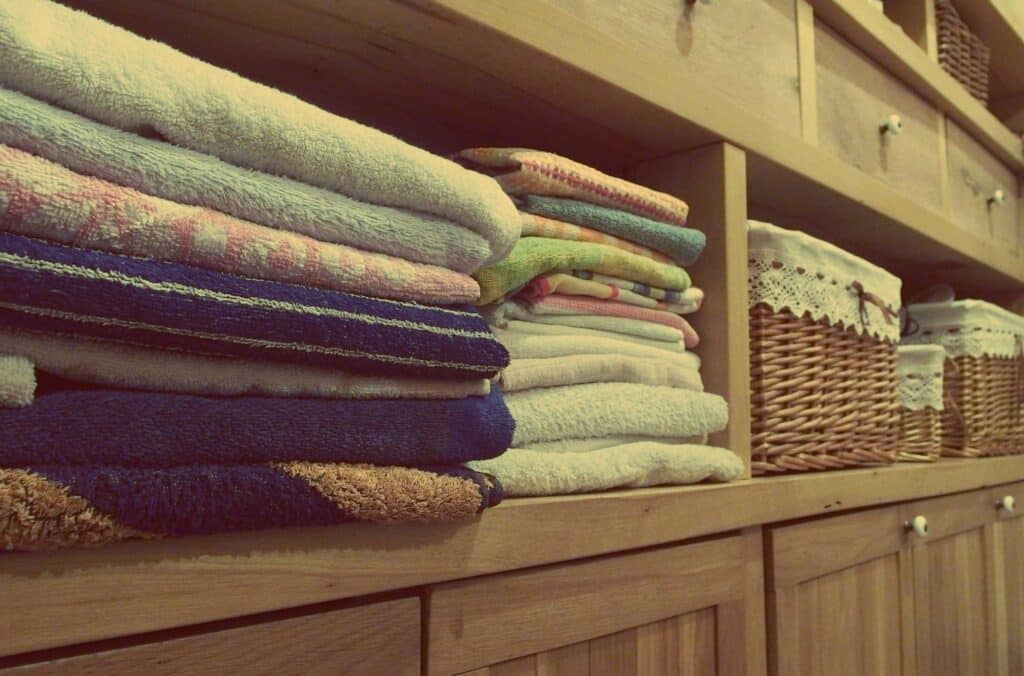How To Read and Follow Laundry Symbols with Ease
Have you ever wondered what those little symbols on your clothing care tags mean? These squiggles and shapes convey essential information about how to take care of your clothes. These icons or pictograms tell us how to clean, dry, and iron the fabric or textile. Knowing how to read these laundry symbols can help you avoid shrinking your favorite sweater or ruining your best pair of jeans.
You can find laundry symbols on the care labels attached to the clothing or textile products, usually sewn into the inside seam or collar of the garment. You should keep these essential labels on to ensure you can clean and iron your clothing correctly every time.
Table of Contents
The Universal Language of Laundry Symbols

There are internationally recognized systems for the care labels to maintain consistency and understanding. The International Standardization Organization (ISO) published the first system in early 1970. In the United States, the American Society for Testing and Standardization (ASTM) published the “Standard Guide for Care Symbols for Care Instructions on Textile Products” in 1996, which defined the symbols and a system for their use.
Their exact use and style may vary slightly based on local norms. However, the symbols are such that they can be universally understood, regardless of language barriers. Many manufacturers also use written instructions in addition to the icons to help make it easier to read clothing care labels.
Basic Laundry Symbols
The most common laundry symbols you will find on clothing are for:
- Washing
- Drying
- Bleaching
- Dry Cleaning
- Ironing
Each of these actions has a base symbol. For example, the washing symbol is a bucket with water, and a triangle indicates the bleaching symbol. Details for each step, such as temperature, chlorine/non-chlorine bleach, and more, are shown inside the symbol using a series of dots, lines, and other characters.
The Wash Symbol
The wash symbol is one of the main symbols on the clothing care tags. It looks like a bucket of water. Here are the most common washing symbols:
- A simple bucket of water indicates you can wash the clothing in a washing machine. You can also wash these items by hand if needed.
- A hand in a water tub indicates the clothing should be hand-washed only. This symbol is used for delicate fabrics that can’t withstand a washing machine’s agitation.
- A number inside the tub of water indicates the maximum water temperature you can use while washing. You may also find dots inside the tub symbol. These show the temperature of water you need to clean the fabric in. One dot means you should use cold water, two for warm water, and three for hot water.
- If you see an “X” on the tub of water, then you should not wash the clothing. You can find this symbol on delicate textiles. If you see this symbol, you should clean them using other methods, such as dry cleaning.
The Bleach Symbol
The triangle symbol indicates whether you can safely use bleach on the garment. Before using any bleach, you should always test the garment for colorfastness. The characters inside the triangle indicate the kind of bleach recommended for the fabric.
The most common bleach symbols are:
- A simple triangle without characters inside indicates you can use chlorine or non-chlorine bleach.
- A triangle with “CL” inside means using chlorine bleach with the fabric is okay.
- A triangle with two diagonal parallel lines suggests using a non-chlorine bleach like an oxygen-based bleach.
- A triangle with an “X” on top means you should not use bleach on the clothing.
The Drying Symbol
A square denotes the drying symbol and tells you how to dry the clothing. Following these symbols is essential to prevent shrinking, color fading, and other damage to your clothes. Clothing can be either tumble-dried or air-dried, each with its own sets of characters.
- A circle inside the square indicates tumble drying, which means you can use a clothes dryer to dry the clothing.
- The number of dots inside the circle indicates the heat you can apply during drying. One means low, two means medium, and three means high heat.
- A solid, filled circle inside the square indicates you should not use heat while drying the clothing in the dryer. You can typically find this on delicate clothing that can distort if heat is used.
- An “X over the tumble-dry ” indicates you should not put the clothing in the tumble-dryer and air-dry it instead.
- Air-drying symbols are square with lines inside to signify various ways to dry clothing without using a tumble dryer.
- Flat dry is a single horizontal line, and drip dry is multiple vertical lines.
- Slanted lines indicate shade and a curved line indicates line dry.
- There can be combinations of these lines to give you more information on drying, like “drip dry in the shade,” which is three vertical lines with slanted lines on the side.
The Dry Cleaning Symbol
A circle denotes the dry cleaning symbol. If you see this symbol, the fabric is dry-clean-only. It would be best if you did not attempt to wash the garment. Instead, you should have these cleaned by a professional dry cleaner.
There can be letters inside the circle. These letters indicate which chemicals or solvents may or may not be used for dry cleaning that fabric. For example, “A” means it can be dry-cleaned with any solvent, “F” means dry-clean with petroleum solvent only, and “P” means dry-clean with any solvent except trichloroethylene. Dry cleaners are aware of these symbols and their meanings. An “X over the circle tells you not to dry-clean that garment.
The Ironing Symbol
The ironing symbol is easy to recognize. It is the outline of an iron. It represents whether you should iron a garment and, if so, at what temperature.
You can see the appropriate temperature settings inside the symbol. These temperature settings can be simple numbers to indicate the maximum temperature of the iron or dots to indicate the heat level. For example, one dot is low heat for textiles like nylon, and two dots are medium heat for fabrics like wool or polyester.
Three small lines coming out from the iron at the bottom indicate steam. The steam from the steam iron circulates inside the textile and relaxes the threads, making it easier to remove wrinkles. If the steam under the iron has an “X” over it, it indicates you should not use steam while ironing as that may damage the fabric.
An “X” over the iron symbol indicates you should not iron the garment. Attempting to iron these fabrics can lead to fabric damage, melting, or other irreversible issues. If you see this symbol on a clothing label, you should explore alternative methods to remove wrinkles, such as steaming or hanging the garment to air out wrinkles naturally.
Clothing Care for the Best Results
Always check the care labels on the clothing before washing and sort them accordingly. It is always best to wash similar fabrics and colors together.
Add a laundry care symbols chart near your washing machine or laundry area for quick reference. If you are ever in doubt, using lower temperatures and gentle cycles to keep the clothing vibrant is always safer.
Understanding clothing care labels will help you ensure your clothing looks great and lasts for a long time.This article originally appeared on Wealth of Geeks.
Latest posts by Anika Gandhi (see all)
- How To Read and Follow Laundry Symbols with Ease - December 23, 2023

